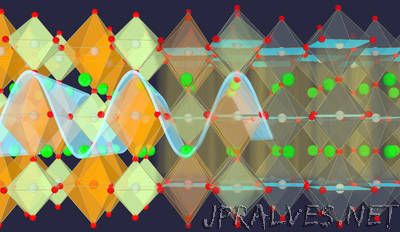
“A study led by scientists of the Max Planck Institute for the Structure and Dynamics of Matter (MPSD) at the Center for Free-Electron Laser Science in Hamburg presents evidence of the coexistence of superconductivity and “charge-density-waves” in compounds of the poorly-studied family of bismuthates. This observation opens up new perspectives for a deeper understanding of the phenomenon of high-temperature superconductivity, a topic which is at the core of condensed matter research since more than 30 years. The paper by Nicoletti et al has been published in the PNAS. Since the beginning of the 20th century, superconductivity had been observed in some metals at temperatures only a few degrees above the absolute zero (minus 273 degrees Celsius). Only in the 1980s, physicists managed to synthetize new classes of compounds, based on ceramic materials, which were able to conduct electricity without any losses at temperatures as high as 138 K (minus 135 degrees Celsius). These were named “high temperature superconductors”. The best known and heavily studied family of high temperature superconductor is that of cuprates, which display by far the highest critical temperatures (i.e. the temperature below which superconductivity occurs), and are therefore the most promising for applications. However, a wide variety of other compounds exists, which also manifest superconductivity at fairly high temperatures, among them the recently discovered iron pnictides. A universal picture able to describe the physics behind the phenomenon of high temperature superconductivity is still missing. However, an important commonality between almost all high temperature superconductors is the emergence of superconductivity in proximity of other exotic phases of matter, such as the “charge-density-waves”. All these materials can be typically tuned from one phase to another, possibly achieving superconductivity, by chemical doping, external pressure, or magnetic fields. However, the subtle inter-relation of these phases remains poorly understood, and in some case, there are evidences that charge-density-waves and superconductivity can even coexist microscopically in the very same compound. In such circumstances, experiments performed by stimulating materials with ultrashort, intense laser pulses (as short as few hundreds of femtoseconds) have been shown in the past to provide new insights in the physics of these systems. For example, the group of Andrea Cavalleri at the MPSD in Hamburg has already successfully demonstrated that, in some cuprates compounds, such pulses can be used to remove charge-density-waves and promote superconductivity at higher temperatures, possibly even up to room temperature (see on the right: W. Hu, Nature Materials, 13, 705–711 and R. Mankowsky, Nature 516 , 71–73). In the present work, Nicoletti, Cavalleri and coworkers focused on different compounds, belonging to the poorly studied family of bismuthates. These superconductors were discovered in the 1970s, even before the cuprates, but they attracted less attention due to their far lower critical temperatures (about 30 K). They share many commonalities, but also some differences with their better-known relatives. In particular, the so-called “parent compound”, BaBiO3, has a robust charge-density-wave phase, from which superconductivity emerges by chemical substitution.”
